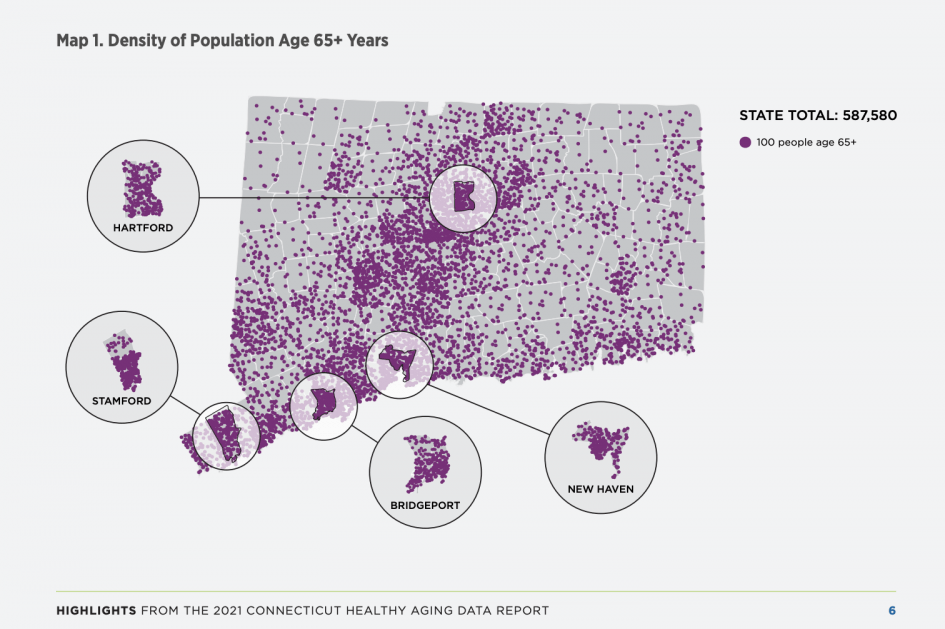Consider a few facts about older people living in Connecticut: Three of every four suffer from hypertension. One of every three have diabetes. Most older adults across the state own their homes, but the rate of ownership ranges from just 37 percent in Hartford to 100 percent in Union. A third of all older adults in Connecticut are widowed.
 None of these individual measures would attract much attention. But gerontology researchers at the University of Massachusetts Boston have collected and published thousands of such facts recently in the Connecticut Healthy Aging Data Report. The depth of data in the report, tracking 190 health indicators in each of Connecticut’s 181 cities, towns, and neighborhoods provides a striking portrait of the entire state’s older population and offers an unprecedented collection of information about individual communities across the state. Gov. Ned Lamont called the report “an important resource to help us shape policy, improve our programs and series, as well as work collectively to engage and act.”
None of these individual measures would attract much attention. But gerontology researchers at the University of Massachusetts Boston have collected and published thousands of such facts recently in the Connecticut Healthy Aging Data Report. The depth of data in the report, tracking 190 health indicators in each of Connecticut’s 181 cities, towns, and neighborhoods provides a striking portrait of the entire state’s older population and offers an unprecedented collection of information about individual communities across the state. Gov. Ned Lamont called the report “an important resource to help us shape policy, improve our programs and series, as well as work collectively to engage and act.”
The Connecticut report is the latest in a series of healthy aging state reports produced by the UMass team over the past decade. Supported by the Tufts Health Plan Foundation, researchers have produced three similarly detailed reports on communities in Massachusetts, two Rhode Island reports, and one for New Hampshire.
See more Healthy Aging Data Reports
“We have been working on this approach for a long time now and we continue to refine the process, bringing additional data and analysis into the mix with the goal of creating the deepest information source possible,” says Elizabeth Dugan, associate professor of gerontology who leads the UMass Boston research team. “We have provided research training for more than 20 doctoral students over the years and benefited from their innovative ideas. We couldn’t do this work without them.”
Dugan and three team members—Professor Nina Silverstein, Professor Emeritus Frank Porell and post-doctoral researcher Chae Man Lee–published two articles about their healthy aging data work in The Gerontologist in the summer of 2021.
The authors envision the same kind of detailed reporting on the health of older adults in many more states, similar in scope to the Kids Count project funded by the Annie E. Casey Foundation that tracks the well-being of children across the United States.
“The time for such an effort focused on the outcomes and futures of older people is now,” they wrote. “Objective, unbiased data to track trends, identify disparities, and evaluate interventions and policies are needed. We envision a network of researchers developing reports for their states, sharing best practices and collaborating on regional, national, and global efforts.”
All of the healthy aging data reports generated by the UMass Boston team have employed a socio-ecological framework. Along with health-specific data on chronic disease and impairment, they researchers track community sources of social support, access to care and food, rates of local crime and pollution, socioeconomics, and behavioral health risks among many others.
Producing profiles of individual towns—or separate neighborhoods in larger cities—creates a more detailed health profile than other resources that typically rely on statewide averages or, in some cases, report at the county level. The community-based health reports more clearly identify healthy aging disparities within a state, an important advantage for policymakers, advocates, and service providers.
“Taken together, these measures provide a more nuanced understanding of community healthy aging and help to identify the determinants and outcomes,” says Dugan. “Tracking the many underlying dimensions of population healthy aging fills in an important but often untold part of the story. By drilling down to such local levels, we make invisible disparities and inequities visible, and help support those seeking to address them.”


Leave a Reply